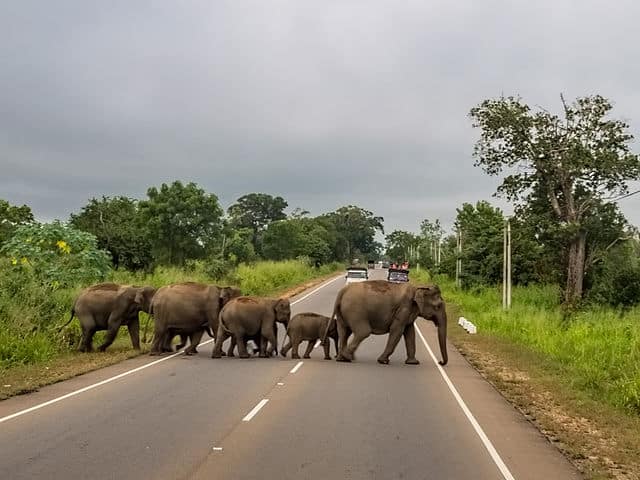A group of elephants cross a main road in Sri Lanka
Revered and loved for hundreds of years, the elephant in Thailand is now not just a national emblem but also a national problem. Thailand’s human population has nearly quadrupled in the last 50 years (from 20 million to 70 million) [1] and most of the natural elephant habitat has been destroyed to provide settlements and farms. As a result, elephant numbers have plummeted over the same period – indeed, Asian elephants are now an endangered species. The wild elephants that are left (around 3,000 in Thailand), once shy and rarely seen, now frequently stray onto roads or trample through human settlements, destroying crops and damaging properties in search of food.
There have been casualties on both sides, though Thailand has a much better record than most other Asian countries in terms of deaths and injuries. Between 2012 and 2018 there were 45 human deaths and at least 25 elephant deaths in Thailand.[2]. Electric fencing, put up by people trying to defend themselves and their property, has been the largest cause of elephant deaths, but elephants also get killed in road accidents, in traps and sometimes they are even shot by irate and frightened farmers. Some authorities have tried capturing and moving problem elephants back to the jungle, but they don’t usually stay there [3].
There are, however, more sustainable options. A study conducted by Thai Foundation Bring the Elephant Home [4] found a willingness among farmers to change to alternative methods of deterrence. These include planting crops which elephants don’t like, like citrus and chilies, along boundaries to help to hide the more delicious sugarcane and rice. Experiments are also being carried out with beehive fencing which provides a safe, natural deterrence and a supplemental income through the sale of honey.
Other research is trying to stay one step ahead of the elephants by monitoring their herds. Mapping migratory routes is made easier with GPS tracking, so it is now possible to identify areas where humans and elephants might overlap – useful information when planning the development of human settlements. For example, rural communities might place themselves near sources of water which are already used by elephants. A solution could be to install irrigation systems in areas further away from elephant habitat. Any human developments and changes need to be made with the elephants in mind, and more sustainable farming could benefit all concerned (see our journal post on rice farming).
Few areas have fair compensation schemes for farmers, but such schemes could go a long way to help reduce animosity towards elephants. Reinforcing, through education, the historic role of elephants in Thai religion and culture will also influence the way local people respond to their national animal (see our posts on Thai culture and religion.) At least in Thailand about 20% of its land is now under protected status [5,6] so here elephants can roam freely without resorting to eating food intended for human consumption.
News stories:
The elephant in the room: a Thai village’s unwelcome guests – photo essay: the Guardian
Thailand’s wild elephants are on the rebound. Not everyone is happy: Sustainability Times
References:
[1] https://worldpopulationreview.com/countries/thailand-population
[2] Seeking Peace with the Pachyderms, The Nation Thailand: https://www.nationthailand.com/in-focus/30350497
[3]You can move an elephant to the jungle, but it won’t stay there, study says: https://news.mongabay.com/2021/11/you-can-move-an-elephant-to-the-jungle-but-it-wont-stay-there-study-says/
[4] https://www.iucn.org/news/thailand/201806/beloved-no-more-new-study-sheds-light-human-elephant-conflict-thailand
[5] Montez, D; Leng, A. (2021). Status of Asian elephant and Human-elephant conflict (HEC) in Asia: A brief and updated review. Journal of Nature and Applied Research. 1 (1), 28-35.
[6] Desai, A.A; Riddle, H.S. (2015). Human-Elephant Conflict in Asia. Available: https://www.fws.gov/international/pdf/Human-Elephant-Conflict-in-Asia-June2015.pdf.
[Click on photos below to enlarge and to read captions]
photo credits: Dan Lundberg (Wikkimedia), IUCN/Bampen Chaiyarak and Ana Grillo






